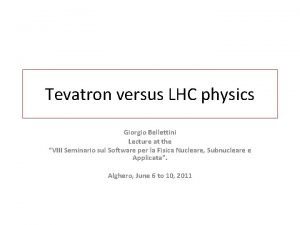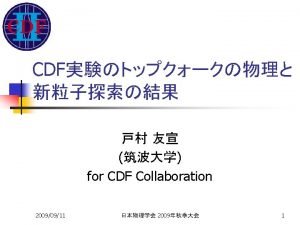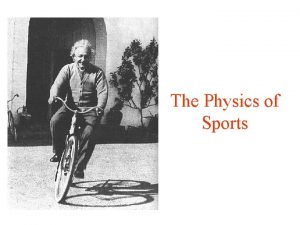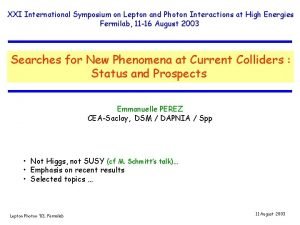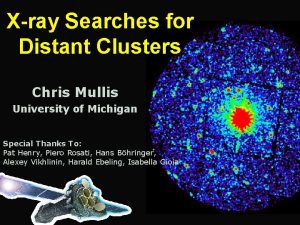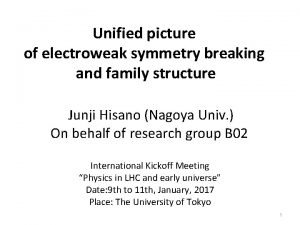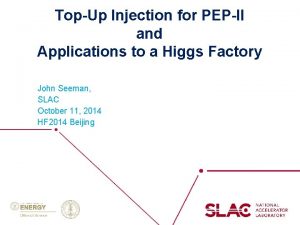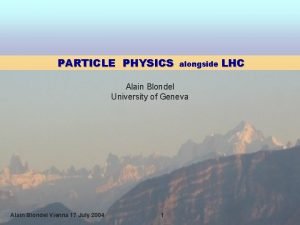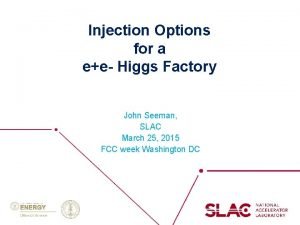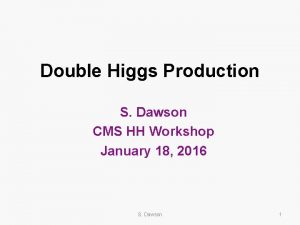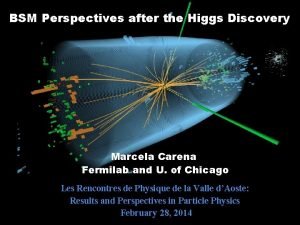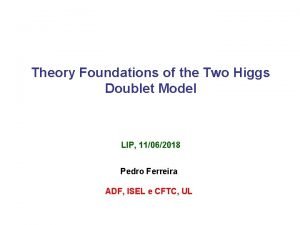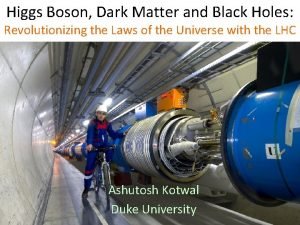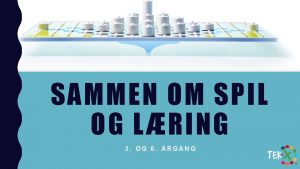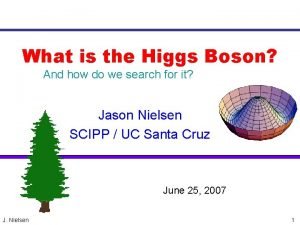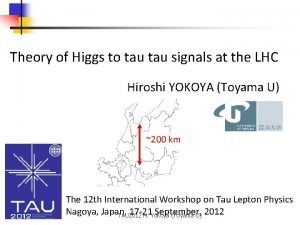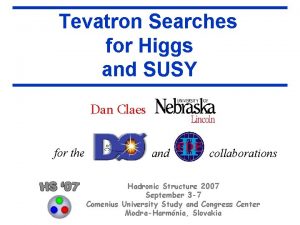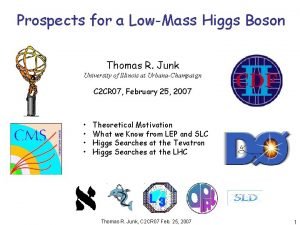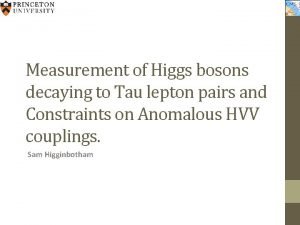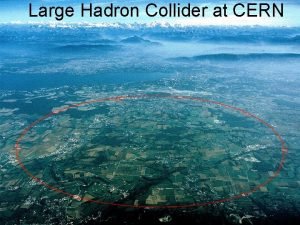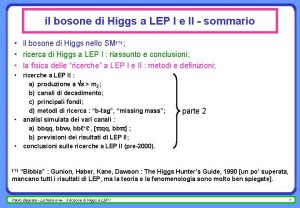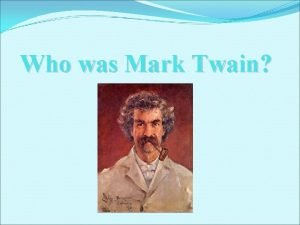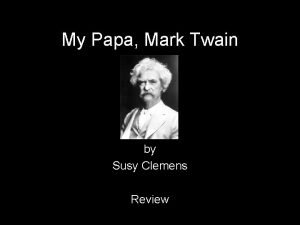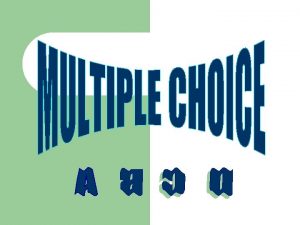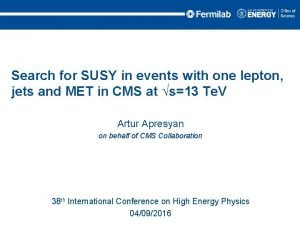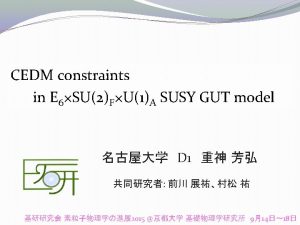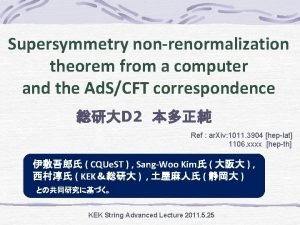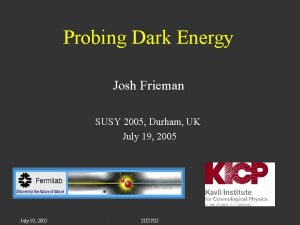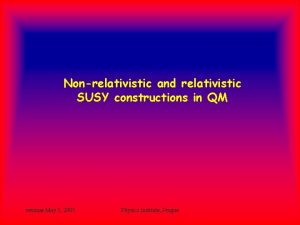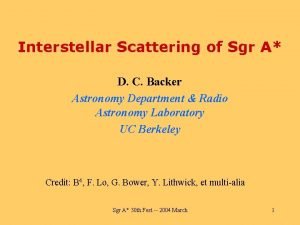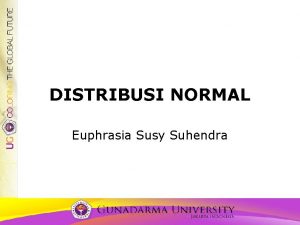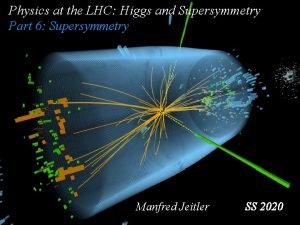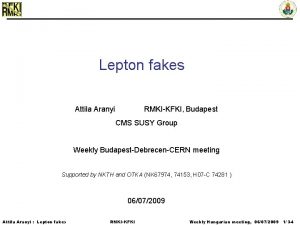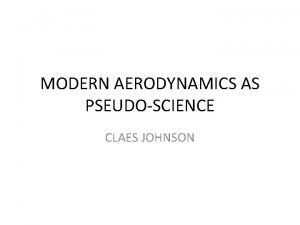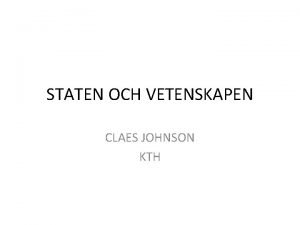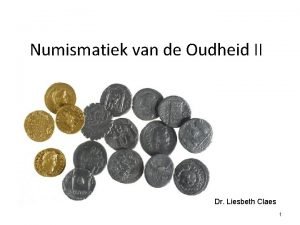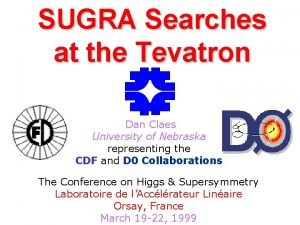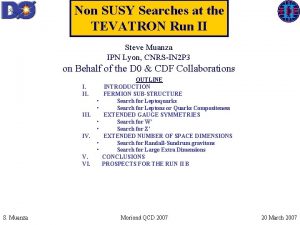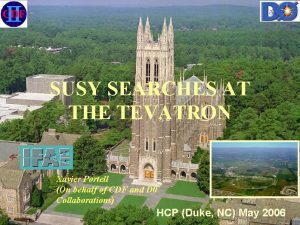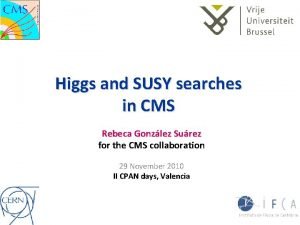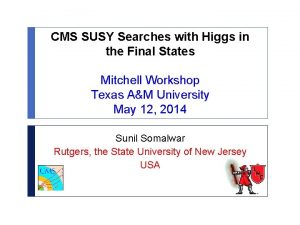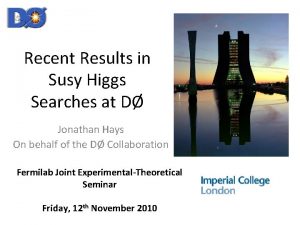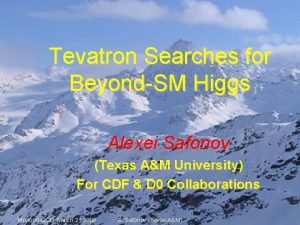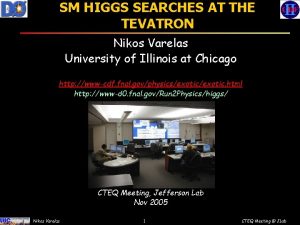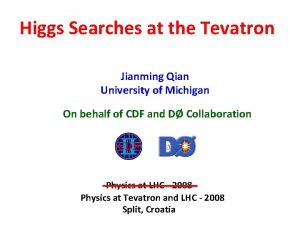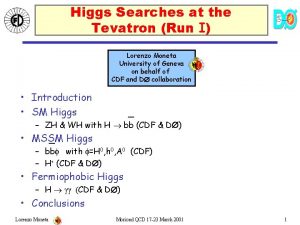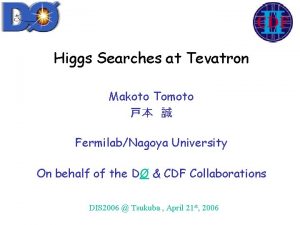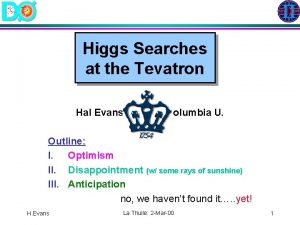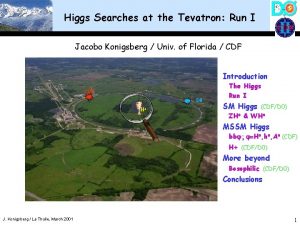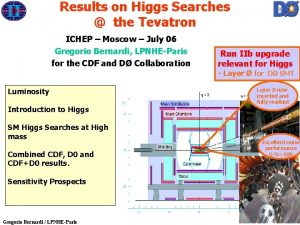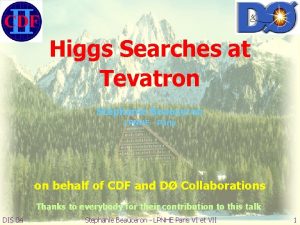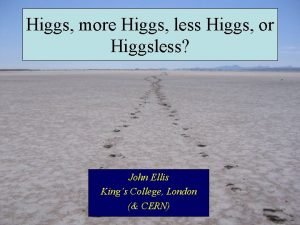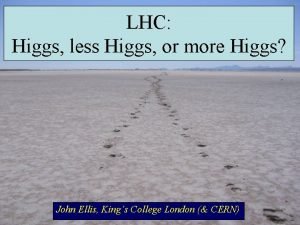Tevatron Searches for Higgs and SUSY Dan Claes










































- Slides: 42

Tevatron Searches for Higgs and SUSY Dan Claes for the and collaborations Hadronic Structure 2007 September 3 -7 Comenius University Study and Congress Center Modra-Harmónia, Slovakia

Searches for contributions to observed events by Higgs decays as well as new phenomena beyond the Standard Model are intensifying as the Tevatron data set grows. CDF Chicago p p 1. 96 Te. V Booster CDF p DØ Tevatron p source p Main Injector & Recycler Proton-antiproton collider operating at COM energy of 1. 96 Te. V

Collider Run II Integrated Luminosity ~3 fb-1 recorded! All the results shown today are based on analysis of 1+ fb-1 Collider Run II Peak Luminosity 4 -8 fb-1 by 2009 Will run for at least two more years!

Higgs production at the Tevatron g g t t H t have seen evidence for single top! q q W/Z H one in ~1012 events could be a Higgs boson!

Nature appears to respect gauge invariance masslessness Through electroweak symmetry breaking within the complex scalar field, V( ), of the Higgs the gauge bosons W, Z acquire mass and a spin-0 Higgs boson appears, its own mass unspecified Higgs self-coupling diverges Allowed unstable vacuum though theoretical considerations do constrain it.

Direct searches reveal m. H > 114. 4 Ge. V/c 2 at 95% confidence The latest LEP Electroweak Working Group fit yields a preferred value of: A Standard Model Higgs should be LIGHT! m. H < 144 Ge. V at 95% confidence limit

Most sensitive searches: m. H<135 Ge. V/c 2 • produced with W or Z boson • decay to b quark pair H->WW Excluded at LEP bb Analysis Strategy m. H>135 Ge. V/c 2 • direct gg H production m. H < 135 Ge. V WH/ZH + H bb • decays to W boson pair m. H > 135 Ge. V Gluon fusion + H WW Background top, Wbb, Zbb WW, DY, WZ

electron/muon neutrino Selection - one or two tagged b-jets - e or with p. T > 15 Ge. V - ET > 20 Ge. V DØ: 4 non-overlapping samples - e or with - 1 “tight” or 2 “loose” b-tags CDF: 2 exclusive samples using different b-tagging algorithms

Limits set cutting on NN output: DØ exp, obs 95/ SM = 9. 05, 11. 1 CDF exp, obs 9. 95, 10. 1

ZH bb Selection: - two acoplanar jets (exactly 2 – CDF) - ≥ 1 tagged b-jets (CDF) 2 tagged b-jets (DØ) - ET > 55 Ge. V (CDF) 50 Ge. V (DØ) b jet

ZH bb Backgrounds : - W+heavy flavour jets - Z +heavy flavour jets - top pairs

Look for enhanced production of Zs: e, Selection: -require two isolated muons or electrons in Z mass window -one or two tagged b-jets CDF - corrects its b-jets with ET projections

1 ‘tight’ b-tag Separate NN trained to reject two main background processes: 2 ‘loose’ b-tags Z + jets 95/SM at MH = 115 Ge. V 20. 4 17. 8 exp 16 obs 16 top pairs

→ hadrons ee → e or same charge → e or Selection: - 2 isolated leptons (p. T > 15 Ge. V) (electrons and/or muons) like-sign! - kinematic likelihood selection , m , ET or di-lepton mass e min T “flips”: charge mis-identification estimated from data: : solenoid vs toroid e: solenoid vs (track, calorimeter)

ee e 20. 6 4. 0 18 5 data 19 15 5 WH(160) 0. 1 0. 2 0. 1 expected background 95/ SM ~ 18 for MH = 160 Ge. V L = 1 fb-1

Selection: - two isolated leptons - large ETmiss - Less than 2 jets (>15 Ge. V) CDF leptons will tend to align If WW comes from a spin-0 Higgs: small ( ) W W: large ( ) 16

Matrix Element Technique most sensitive at high masses

SUMMER 2006 • • Combines sixteen mutually exclusive final states for WH, ZH, WW - 10. 4 SM at m. H=115 Ge. V - 3. 8 SM at m. H=160 Ge. V Today I’ll report on recent progress – updated CDF & DZero low & high mass 1+ fb-1 analyses

Combines sixteen mutually exclusive final states for WH, ZH, WW 7. 7 SM at m. H=115 Ge. V 1. 4 SM at m. H=160 Ge. V

Higgs Bosons Beyond the Standard Model The Standard Model assumes a single complex Higgs doublet generates W/Z masses and a massive chargeless spin-0 boson, the Higgs, H 2 HDM: 2 Higgs Doublet Models • Hu/Hd couple to up- and downtype quarks • tan β is the ratio of their vev’s tan β = <Hu>/<Hd> • EWSB results in 4 massive scalar (h, H, H±) and one massive pseudoscalar (A) Higgs bosons ( ) Minimal Supersymmetric Model At large tan enhanced 0 bb and 0 tt couplings mean large Higgs production rates at hadron colliders! • fully parameterized (at tree level) by tanβ, m. A • with radiative corrections that depend on stop mixing

Fermiophobic Higgs Decaying to 3 A production mechanism unique to hadron colliders is accessible to the Tevatron provided m. H is not too large! For tan > 1, m. H < 200 Ge. V and mh < 90 Ge. V B(h ) 1 and B( H h. W ) 1 Background rates in 3 final state are very low • measured fake rates for Z or W • tri-photon production extrapolated from di-photon sample No obvious structure in diphoton mass spectrum Optimizing selection on 3 s ET > 30, 25 Ge. V 0 events observed 1. 1 0. 2 expected background

Fermiophobic Higgs Decaying to 3 Optimizing final selection on 3 s ET > 30, 25 Ge. V and p. T > 25 Ge. V rejects background Process Events expected direct 3 0. 9 0. 2 estimated 3 fakes 0. 3 0. 05 Observed 0 LEP 2 limits of 108 Ge. V/c 2 assumed SM coupling hf V V

Fermiophobic Higgs in 2 + X 1. 1 fb-1 Selection: 2 photons (p. T > 25 Ge. V) Background: , +jet and jet+jet mh>92 Ge. V at 95% CL

b (b) bb b(b) Search b g 0 b g b 0 At high tan Br(H/A bb) 90%, but swamped by QCD background Look for associated production with bs. Selection: - 3 b-tagged jets - look for a signal in the invariant mass of two leading jets The shape from double–tagged events ( mis-tagged rate) Normalized to the 3 b-tagged sample outside the signal mass window. ALPGEN MC

b (b) bb b(b) Search CDF found two useful discriminators • m 12 (invariant mass, 2 leading jets) • mdiff = mass of the tracks assigned to jet from the displaced vertex 0. 90 fb-1 0. 980 fb-1

Neutral MSSM Higgs had Main backgrounds: Z (irreducible), W+jets, Z ee, , mulijet, di-boson DØ: -channel only • 1 isolated separated from opposite sign hadronic • set of 3 NNs discriminate from jets CDF: e, , e+ channels • isolated e or separated from opposite sign hadronic • variable-size cone algorithm for > 55 Ge. V • mvis < 20 Ge. V removes • remaining W background • Ws removed by a cut on the MET projected on the bisector between s.

Neutral MSSM Higgs had Small excess in CDF’s e + channel • but < 2 effect • not observed in CDF e channel While DØ is in good agreement with SM

Neutral MSSM Higgs had Both experiments give similar results: in the 90<m. A<200 Ge. V region tan > ~40 -60 excluded for the no-mixing and mhmax benchmarks

SUPERSYMMETRY Particle Name gluon charged Higgs charged weak boson light Higgs heavy Higgs pseudoscalar Higgs neutral weak boson photon quark lepton Symbol g H+ Spartner Name gluino chargino h H A Z neutralino q l squark slepton The Lightest Supersymmetric Particle provides • ET if the LSP is stable and R-parity is conserved • photons and ET if the LSP is a gravitino and NLSP a neutralino • long-lived particles if the LSP decays weakly Symbol ~ g ~1, 20 ~1, 2, 3, 4 q~R, L ~l R, L SUSY particles are heavy • high p. T final state objects

Minimal Supersymmetric SM Extension adding the fewest new particles • 2 Higgs doublet h 0 H 0 A 0 H + • and described by 4 parameters M 1 M 2 tan U(1) U(2) gaugino mass parameter at EW scale higgsino mass parameter ratio of VEV of Higgs doublets • scalar sector described by MANY mass parameters • different SUSY breaking different class of models MSSM Assumptions: • SUSY particles are pair produced • Lightest SUSY particle (LSP) is stable SUSY Symmetry Breaking SUGRA( ~ 10 11 Ge. V) • 5 free parameters mo common scalar mass m 1/2 common squark mass Ao trilinear coupling tanb sign( ) • Lightest SUSY particle is

Stop charm + ET ~ with 0 as Lightest Supersymmetric Particle and R-parity pair production Search for: 2 charm jets plus Missing ET Pre-selection: 2 jets, p. T > 40(20) Ge. V Lepton, track vetos δφ(jj) < 165 o δφmax - δφmin < 120 o δφ(j, ET) > 50 o A=(ET-HT)/(ET+HT)>-0. 05 ET> 60 Ge. V then flavor tag (>= 1 jet)

Stop charm + ET Finally optimize mass-dependent cuts on HT and P = max + min For HT>140 P<320 SM process Number of events W l +jets Z +jets * W l +HF (bb, cc) Z +HF (bb, cc) WW, WZ, ZZ tt Single top Z ll(e, , )+jets Z ll(e, , )+ HF (bb, cc) 20. 62 2. 34 13. 23 1. 76 11. 94 1. 06 11. 60 0. 78 2. 70 0. 27 2. 17 0. 07 1. 76 0. 05 0. 12 0. 09 0. 04 Total BKG 64. 21 3. 22 Data 66 *use Z ee+jets to normalize Z vv+jets

Search for Long-lived Stop Some models predict long-lived massive particles due to: – weak coupling (e. g. , NLSP in SUSY models with GMSB) – Kinematic constraints (chargino in SUSY with AMSB) – New symmetry (gluino in split-SUSY, LSP stop in ED models) A long-lived, charged massive particle (CHAMP) appears as a “slow” muon. – High PT, low velocity, highly ionizing “muon” – Measure velocity ( ) via TOF detector + timing from tracking detector – Calculate mass from momentum and Electromagnetic Calorimeter (EM) CDF TOF Hadronic Tracking Calorimeter Chamber Muon Detector Control Region dominated by W Signal Region Data

Search for Long-lived Stop • Signal region: no candidates with m>120 • consistent with expected background Prospino 2 Exclude stable stop with m<250 Ge. V/c 2 at 95%CL

Squarks/Gluinos jets + ET Assuming R-partity is conserved, squarks and gluinos can decay directly into the LSP ( 01). or cascade down to the LSP The dominant signature for qg, gg + X is jets+E pp qq, T Separate 2 -jet, 3 -jet and >3 -jet analysis. At least 3 jets ET > 25 Ge. V and ET > 25 Ge. V

Squarks/Gluinos jets + ET 1. 4 fb-1 Mgluino < 290 for any Mq~ Mgluino < 380 excluded for Mg~ ~ Mq~ A 0=0 tan = 5 <0

Squarks/Gluinos jets + ET 0. 96 fb-1 ~ ~ Mgluino < 402 excluded for Mg~Mq Mgluino < 309 excluded – any Mq~ A 0=0 tan = 3 <0

Squarks had + jets + ET τ- Selection: • 2 or more jets ET > 35 Ge. V • ET > 75 Ge. V • at least one hadronic Optimization: • ET > 175 Ge. V • > 325 Ge. V A 0 = -2 m 0 tan = 15 <0 enhanced decay

Squarks had + jets + ET Predicted Yields Signal (m 0, m½) ( 80, 160) 4. 7 0. 4 (100, 150) 7. 1 0. 6 Background 1. 7 Data 2 Translating to LEP 2 slepton searches LEP 2 chargino searches

Chargino/Neutralino Trileptons Production of 1 02 will lead to trilepton final states with ET perhaps the cleanest signature of supersymmetry. Dominant backgrounds: Dibosons and Drell-Yan with converting bremsstrahlung photon ee+track • Limits set on Br as a ~ function of mass • Results interpretted within select m. SUGRA scenarios Large and Br ~ Maximal 3

Chargino/Neutralino Trileptons DØ ee+track: Final Selection Signal: 1 -2 events Background: 1 0. 3 Data: 0 DØ Combined Limit (5 analysis) : DØ Combined Limit (14 analysis) :

Conclusions
 Tevatron vs lhc
Tevatron vs lhc Tevatron cdf
Tevatron cdf Tevatron
Tevatron Superjets tevatron
Superjets tevatron Exploded/cross projection sketch
Exploded/cross projection sketch Xray searches
Xray searches Higgs singlet
Higgs singlet Higgs factory
Higgs factory Cern geneva
Cern geneva Higgs factory
Higgs factory Higgs singlet
Higgs singlet Marcela carena
Marcela carena Weinberg salam theory
Weinberg salam theory Higgs boson black hole
Higgs boson black hole Chelsea higgs wise
Chelsea higgs wise Hungry higgs
Hungry higgs Higgs boson
Higgs boson Higgs to tau tau
Higgs to tau tau Higgs
Higgs Higgs boson
Higgs boson Higgs
Higgs Playfer
Playfer Bosone di higgs
Bosone di higgs Mark twain wife
Mark twain wife Mark twain father
Mark twain father Susy
Susy What excites lennie most about his dream life with george
What excites lennie most about his dream life with george Susy dala
Susy dala Susy dala
Susy dala Susy model
Susy model Susy isn't a normal maid
Susy isn't a normal maid Susy qm
Susy qm Susy shear
Susy shear Susy klein
Susy klein Windbland
Windbland Euphrasia susy suhendra
Euphrasia susy suhendra A supersymmetry primer
A supersymmetry primer Susy
Susy John spesak
John spesak Claes oldenburg burger
Claes oldenburg burger Claes johnson
Claes johnson Claes feinbaum
Claes feinbaum Quandrans
Quandrans
